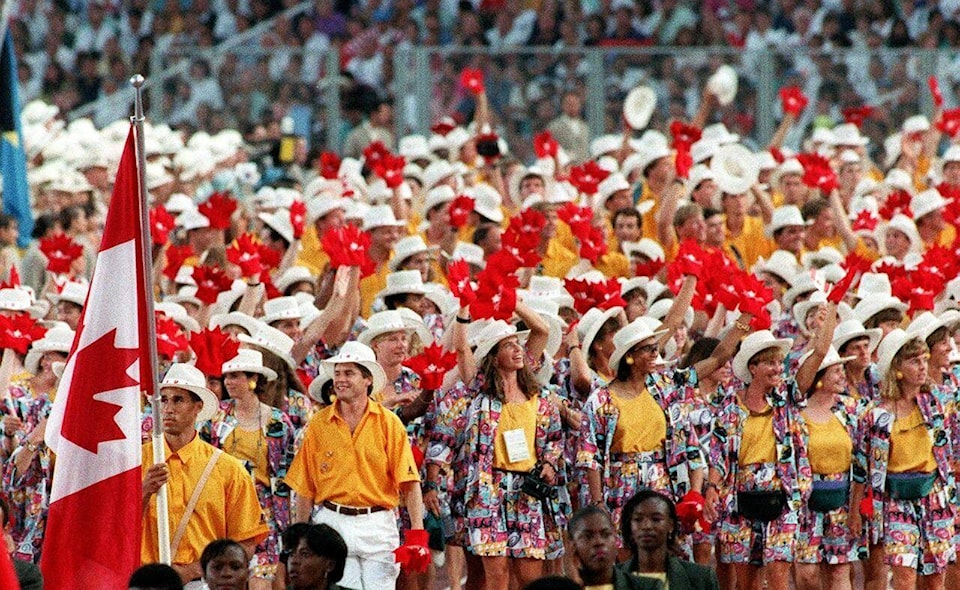Canada’s Olympic attire tends to consist of predictably patriotic fare: variations on the same red-and-white, Maple Leaf-adorned uniforms we see year after year.
But every now and then, Canada will make a fashion statement as it shows off its athletic might on the international stage.
As Lululemon tries its hand at outfitting athletes for the upcoming Winter Games in Beijing, we look back at some of the winners and losers in Team Canada’s wardrobe throughout the years.
The Tokyo “Canadian Tuxedo”
Team Canada leaned into national stereotype at the Tokyo Olympics this summer with a street-style twist on the denim-on-denim getup known as the “Canadian tuxedo.”
Official designers, the Hudson’s Bay Co. and Levi’s, outfitted the country’s athletes in graffiti-emblazoned jean jackets and white denim pants for the Games.
The uniforms were the subject of widespread social media mockery. Shortly after the looks were unveiled in April, New York Times culture writer Dave Itzkoff tweeted, “This is the gang that comes after you if you say you tried watching ‘Schitt’s Creek’ but couldn’t get into it.”
Lucia Kinghorn, vice-president of design at Hudson’s Bay, stood by the tribute to one of Canada’s most famous fashion exports.
“For as many naysayers, we have even more fans,” she said. “We’re proud of the thoughtful design behind Team Canada’s clothing and happy that so many people are talking about it.”
The Red Mittens
HBC’s red knit mittens were the must-have souvenir of the Vancouver Olympics in 2010.
About three million pairs of the original mitts, which featured a white Maple Leaf on each palm, were sold. Oprah Winfrey even handed out pairs to her studio audience during the Games.
Hudson’s Bay embraced the winter wear as “a symbol of Canadian pride and unity,” releasing several updated versions in the decade after the launch.
The company says its campaign to donate a portion of red mitten sales to Canadian athletes has raised tens of millions of dollars.
The Nagano Cap
Roots turned heads at the 1998 Winter Games in Nagano with its “poor boy” hat, a red fleece cap with a short brim that was often worn backwards to show “Canada” embroidered in bold white letters.
The beret-like headgear became a sensation at home and abroad, with more than 500,000 caps sold and worn by the likes of Prince William and hip-hop mogul P. Diddy.
Calgary Cowboys
Calgary’s western roots were on full display when the city hosted the Winter Games in 1988.
Team Canada donned wide-brimmed cowboy hats and red trench coats with fringe lapels to welcome the world’s athletes to “Cowtown.”
The Turin “Trapper” Hat
As Canada’s oldest department store, Hudson’s Bay drew from its centuries-old history in the fur trade to find inspiration for Team Canada’s styles at the 2006 Olympics in Turin, Italy.
The trapper hat, lined with shearling or — for fashionistas concerned with animal welfare — faux shearling, offered a modern take on the traditional headgear fitted with frost-fighting earflaps.
The Bold Looks of Barcelona
“More is more” seems to have been the prevailing style sensibility for Team Canada at the 1992 Summer Games in Barcelona.
The opening ceremony outfits were made with loose-fitting fabric patterned with bold and bright geometric designs — with yellow, pink, turquoise and purple replacing the usual red-and-white colour schemes.
Accessories included cowboy hats, bulbous yellow earrings, fanny packs and maple leaf-shaped gloves the athletes wore while waving at the crowd.
— with files from The Associated Press
This report by The Canadian Press was first published Oct. 26, 2021.
